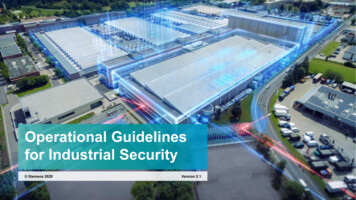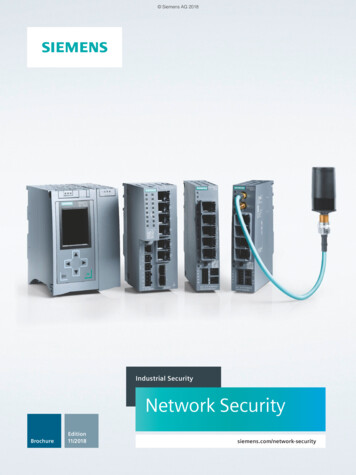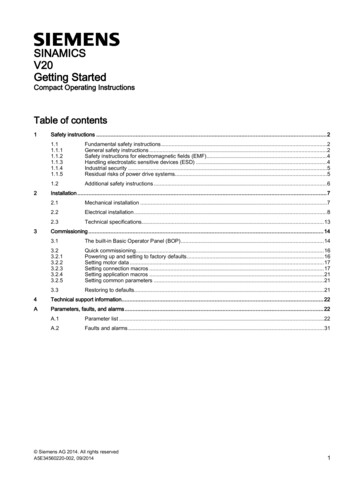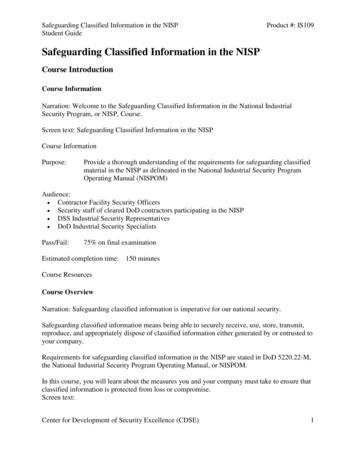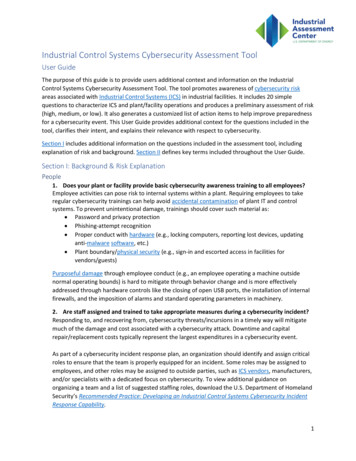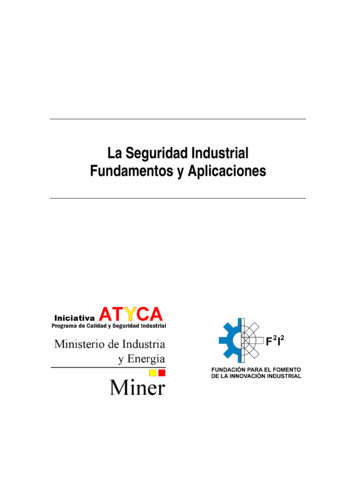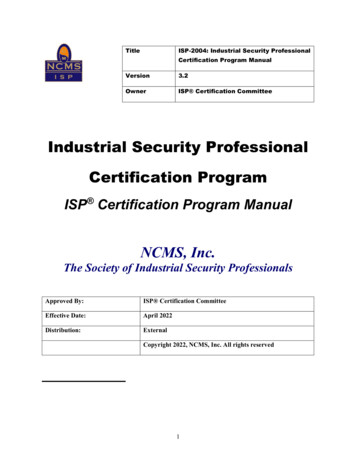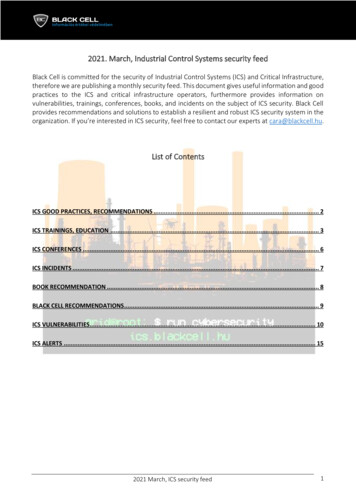
Transcription
Introduction to IndustrialSecurity, v3Student GuideSeptember 2017Center for Development of Security Excellence
Introduction to Industrial Security, v3Student GuideLesson 1: Course IntroductionIntroductionIntroductionSubcontractor CEO: I’m really excited -- my company, BuildGen Contracting, just won ourfirst classified subcontract! But now we need to make sure we establish an effective securityprogram to protect classified information. Where do we begin?Prime Contractor FSO: Congratulations! We look forward to working with you on this effort!There are several steps you and your company will need to take before you can accessclassified information under this contract, and there’s a lot of information that you will needto be aware of.Main Narrator: Whether you work for a company that is working on its first classified contractor a company with existing classified contracts, protecting classified information is a priorityfor all government and industry employees. Did you know that much of all U.S. classifiedinformation is developed by industry? Every day, contractors have access to classified andControlled Unclassified Information, or CUI, as well as government facilities, informationsystems, and equipment.With that in mind, you can see the need to have security guidelines and procedures that areclosely monitored, with one goal in mind—to protect our national security by providing forthe security of our sensitive and classified information.Welcome to the Introduction to Industrial Security course.ObjectivesThis course will provide an overview of the National Industrial Security Program, or NISP,including its purpose and structure, key roles, the classified contracting process and contractrequirements, and the basic security clearance processes and requirements.These topics are very broad, so when there is an opportunity for you to learn more, thecourse will direct you to additional courses that will be helpful.Here are the course objectives. Take a moment to review them. Recognize the role of the National Industrial Security Program (NISP) in theprotection of classified information entrusted to industryDescribe government and contractor security roles and responsibilities in accordancewith the NISP Operating Manual (NISPOM)Outline the process and requirements for establishing a classified contractSeptember 2017Center for Development of Security ExcellencePage 1-1
Introduction to Industrial Security, v3 Student GuideIdentify the security clearance processes and procedures required for access toclassified informationSeptember 2017Center for Development of Security ExcellencePage 1-2
Introduction to Industrial Security, v3Student GuideLesson 2: Overview of the NISPIntroductionObjectivesSubcontractor CEO: I need more help with the NISP. I’m not sure I understand how itapplies to my new classified contract and all that may be involved or expected of us.Prime Contractor FSO: The NISP, or National Industrial Security Program, is the programthat oversees the safeguarding of classified information used by cleared contractors, like ourcompanies. It defines the requirements, restrictions, and other safeguards that prevent theunauthorized disclosure of classified information, and it oversees their implementation.Main Narrator: This lesson will provide an overview of the purpose and structure of theNISP, and its role in safeguarding classified information entrusted to industry.Here are the lesson objectives. Take a moment to review them. Identify the purpose of the National Industrial Security Program (NISP)Recognize the role of the NISP Operating Manual (NISPOM)Define Cognizant Security Agencies (CSAs) and Cognizant Security Offices (CSOs)Identify the role of CSAs and CSOs in the NISPIdentify the role the Defense Security Service (DSS) plays in NISP administrationand oversightWhat is the NISP?Purpose of the NISPThe majority of our nation’s technology is developed and produced by industry – and muchof that technology is classified. The U.S. Government entrusts cleared contractor facilitieswith access to classified and Controlled Unclassified Information, or CUI, governmentfacilities, information systems, and equipment.The National Industrial Security Program, or NISP, is a Government-Industry partnershipestablished in 1993 by Executive Order 12829. The NISP ensures that cleared industrysafeguards classified information in its possession. Within the NISP, the governmentestablishes the requirements for the protection of classified information, and industryimplements these requirements with the government’s advice, assistance, and oversight.The NISP applies to all Executive Branch Departments and Agencies and to all clearedcontractor facilities in the United States, and is designed to be cost effective and efficient.September 2017Center for Development of Security ExcellencePage 2-3
Introduction to Industrial Security, v3Student GuideIt defines the requirements, restrictions, and other safeguards designed to preventunauthorized disclosure of classified information and calls for close monitoring of thesecritical guidelines and procedures.NISP Operating ManualThe Department of Defense, or DoD, Regulation 5220.22-M, more commonly referred to asthe National Industrial Security Program Operating Manual, or NISPOM, defines therequirements, restrictions, and safeguards that industry must follow.The NISPOM provides guidance so that security can be implemented uniformly across awide range of contractors, but it is also general enough that it may be customized for eachcontractor’s situation and needs.NISPOM topics include: General policies and proceduresReporting requirementsFacility Clearances (FCLs)Personnel Security Clearances (PCLs)Foreign Ownership, Control, or Influence (FOCI) issuesSecurity training and briefingsClassificationMarking requirementsSafeguarding of classified informationVisits and meetingsSubcontractingInformation System (IS) securitySpecial requirements, including nuclear-related information, Critical Nuclear WeaponDesign Information (CNWDI), intelligence information, and Communications Security(COMSEC)International security requirementsClassified and Sensitive Unclassified ContractsWhen industry provides a service to the government, all security details must be covered inthe contract, including requirements for safeguarding classified information and what level ofclearance employees involved in the contract will need, among other concerns. This securityguidance must be adhered to by the contractor and all of its employees.Although the NISP only covers contracts that involve classified materials, unclassifiedcontracts can still involve critical or sensitive information that requires safeguarding, such asPersonally Identifiable Information, or PII, or budgets.September 2017Center for Development of Security ExcellencePage 2-4
Introduction to Industrial Security, v3Student GuideFor both classified information and CUI, contracts must identify the security requirementsand how the contractor will be reimbursed for associated costs. Contracts can specifyadditional security requirements that go above and beyond what the NISPOM requires butclassified contracts can never be less restrictive than what is required by the NISPOM.Structure of the NISPGovernment and Industry ResponsibilitiesIn order to implement the NISP and protect classified information, government agencies andindustry contractors play important but distinct roles.On the government side, Cognizant Security Agencies, or CSAs, establish general industrialsecurity programs and oversee and administer security requirements. Each CSA has one ormore Cognizant Security Offices, or CSOs, which administer the NISP on their behalf.For a specific contract, the Government Contracting Activity, or GCA, represents the agencythat issues the contract. The GCA provides industry with contract-specific securityclassification guidance. The GCA has broad authority regarding acquisition functions for itsagency, as delegated by the agency head. The designation of a CSO does not relieve theGCA of its responsibility to protect and safeguard classified information. Securityrequirements outside the scope of the NISP require oversight from the government agencyor organization that levied those requirements upon the contract.Finally, based on their classified involvement in the NISP, industry has one majorresponsibility: they must implement the applicable NISPOM requirements needed to protectclassified information.CSAs and CSOsCSAs, are those agencies authorized by Executive Order 12829 to establish industrialsecurity programs and oversee and administer security requirements.There are five CSAs that are ultimately responsible for the security of all cleared U.S.contractors. The Department of Defense, or DoD, is the largest CSA with the most classifiedcontracts with industry. Other CSAs include the Office of the Director of NationalIntelligence, or ODNI, the Department of Energy, or DoE, the Nuclear RegulatoryCommission, or NRC, and the Department of Homeland Security, or DHS. Each CSA hasone or more Cognizant Security Offices, or CSOs, which administer the NISP.The Defense Security Service, or DSS, has been designated as the CSO for the DoD andover 30 other non-DoD agencies, including DHS, who have entered into agreements withthe DoD. You can view a list of agencies with DSS agreements on the DSS website.Depending on the security requirements of the classified programs involved, othergovernment agencies may also assume some of the CSO functions.September 2017Center for Development of Security ExcellencePage 2-5
Introduction to Industrial Security, v3Student GuideDoD Delegation of Security CognizanceAs you just learned, the DoD is the largest of the CSAs, and it delegates securitycognizance to DSS as its CSO.As CSO, DSS administers the NISP; provides security guidance, oversight, and policyclarifications; and conducts periodic Security Vulnerability Assessments, or SVAs, to ensureadherence to the NISPOM and contract guidelines.DSS is responsible for the oversight of all NISPOM requirements. Some of the morecommon security elements that DSS oversees as CSO include: storage of classifiedinformation; visit procedures; security awareness and training; procedures for protectingclassified on Information Systems, or ISs; Personnel Security Clearances, or PCLs, foremployees working on classified contracts; any changes in ownership, management, orforeign involvement; and compliance with reporting requirements.Security Cognizance ConsiderationsDSS oversees U.S. cleared contractor facilities participating in the NISP. Some of thesecompanies access classified information at their own facilities and some access classifiedinformation at another cleared contractor or government or agency site. Regardless ofwhere their access takes place, all cleared contractors must follow the applicable securityprocedures, as documented in the NISPOM.DSS might not have security oversight for classified contract work being performed on agovernment installation. Those contracts may have different requirements from classifiedcontract work performed at the contractor’s own cleared facility or at another clearedcontractor site, and contractors working on government installations or agency sites mustfollow all standard operating procedures for the installation or agency. These proceduresmay be more restrictive but should never be less restrictive than what the NISPOM requires,must be clearly outlined in the contract, and are typically established and overseen by theinstallation commander, who has security cognizance in accordance with DoD 5220.22-R,the Industrial Security Regulation. The installation commander or head of the User Agency,or UA, can request in writing that DSS assume cognizance.Note that if the contractor is performing entirely unclassified work on a military installation,DSS is not involved, although in some cases, additional security requirements may appearin the contract.Finally, note that when cleared contractors work on a Special Access Program, or SAP, theProgram Manager may retain some of the CSO’s responsibilities.Information Systems SecurityClassified Information Systems, or ISs, can be important assets with significant implicationsfor national security. Many store large amounts of valuable information and need continuousSeptember 2017Center for Development of Security ExcellencePage 2-6
Introduction to Industrial Security, v3Student Guideprotection. Contractors may operate their own ISs, they may use government-ownedsystems at the government or agency site, or they may use a government-owned system attheir own cleared contractor site.Contractors operating their own systems must follow the provisions laid out in chapter 8 ofthe NISPOM. Contractors accessing government-owned systems at the government sitemust follow the security provisions outlined by the owner of the system, and theseprovisions and requirements must be specified in the contract. And in cases wherecontractors operate government-owned systems at the contractor site, the requirements ofNISPOM Chapter 8 take precedence.Lesson 2 Review ActivitiesReview Activity 1Contractor CEO: My company, BuildGen Contracting, just won its first classified governmentcontract. What are our NISP responsibilities?What are contractor responsibilities according to the NISP?Select the best response. Check your answer in the Answer Key at the end of this StudentGuide. Establish NISP requirements for the protection of classified information Provide advice, assistance, and oversight Implement NISP requirements for the protection of classified informationReview Activity 2Contractor CEO: Can you help me understand what the difference is between CSAs andCSOs?Identify whether the following statements describe CSAs or CSOs. Check your answer in theAnswer Key at the end of this Student Guide.These organizations establish industrial security programs and oversee securityrequirements. CSA CSOThese organizations administer the NISP and provide security guidance, oversight, andpolicy clarifications. CSA CSOSeptember 2017Center for Development of Security ExcellencePage 2-7
Introduction to Industrial Security, v3Student GuideReview Activity 3Contractor CEO: I understand DSS will be the CSO for our company. What will they do forus?Which of these are DSS responsibilities or functions?Select all that apply. Check your answer in the Answer Key at the end of this Student Guide. Provide security guidance and oversight Provide policy clarifications Conduct Security Vulnerability Assessments (SVAs) Provide installation-specific procedures for work performed on a governmentinstallation Provide contract-specific security classification guidanceSeptember 2017Center for Development of Security ExcellencePage 2-8
Introduction to Industrial Security, v3Student GuideLesson 3: Security Roles in the NISPIntroductionObjectivesSubcontractor CEO: Okay, so now I understand the basic structure of the NISP but I stillhave some questions. Is there someone I can talk to?Prime Contractor FSO: Yes, there are several individuals in government roles who areassigned to help contractors like you navigate the NISP and ensure classified information isprotected.Main Narrator: Recall that in order to protect classified information, government agenciesand industry both have a role to play in the NISP. Within each of these organizations,different individuals do their part to make sure that classified information is protected.Here are the lesson objectives. Take a moment to review them. Recognize the main government security roles described in the NISPOM Recognize the main contractor security roles described in the NISPOM Identify how government and contractor personnel work together to ensure thesecurity of information used in classified contractsOrganizational Roles and ResponsibilitiesDSS Mission: Regional NISP AdministrationBefore exploring the roles that individuals play in the NISP, let’s take a moment to reviewthe roles and responsibilities of the organizations that support the NISP.Recall that the DoD is the largest Cognizant Security Agency, or CSA, and has designatedDSS, as its Cognizant Security Office, or CSO. As CSO, administration of the NISP is key tothe overall DSS mission, and much of that administration is carried out by the DSS IndustrialSecurity Field Operations, or ISFO. ISFO provides oversight and conducts SecurityVulnerability Assessments, or SVAs, for over 13,500 cleared contractor facilities.ISFO maintains Industrial Security Field Offices throughout the country. Field offices aregrouped into four geographic regions. Each region is led by a regional director, whooversees the operation of field offices located throughout his or her region.Each Field Office is locally managed by a Field Office Chief, or FOC, and staffed byIndustrial Security Representatives, or IS Reps. The FOC assigns an IS Rep to eachcontractor facility.September 2017Center for Development of Security ExcellencePage 3-9
Introduction to Industrial Security, v3Student GuideISFO Headquarters FunctionsIn addition to overseeing the field offices and their operations, ISFO oversees several DSSheadquarters components including the Facility Clearance Branch, or FCB, which processescompanies for Facility Clearances, or FCLs, issues FCLs, and monitors companies that holdFCLs.ISFO also oversees the Personnel Security Management Office for Industry, or PSMO-I,which processes PCLS and monitors personnel security eligibility and access forcontractors.Finally, ISFO oversees the NISP Authorization Office, or NAO. NAO carries out DSSAssessment and Authorization, or A&A, determinations for contractor Information Systems,or ISs, to process classified information.To learn more about each of these headquarters components, see the DSS ISFO website.Select VIEW to access this website from a list of Course Resources.Government RolesOverview of DSS RolesDSS provides security support to a large number of military services, defense agencies,non-DoD Federal Agencies, and cleared contactor facilities. To do this, it relies onindividuals in a variety of roles.IS Reps serve as the contractor’s primary point of contact for security matters and areresponsible for contractor oversight in the NISP. There are over 200 IS Reps locatedthroughout the country.The Information System Security Professional/Security Control Assessor, or ISSP/SCAworks with IS Reps and contractor personnel on all matters related to the authorization andmaintenance of authorized contractor ISs.Finally, Counterintelligence Special Agents, or CISAs, provide advice, oversight, andtraining regarding Counterintelligence, or CI, issues.Let’s review each of these roles in greater detail.IS RepIndustrial Security Representatives (IS Reps) serve as the contractor’s primary point ofcontact for security matters. They work closely with the contractor’s FSO, to provide advice,assistance, and oversight.IS Reps conduct SVAs to ensure the program is in compliance with the NISPOM andreceive change conditions and suspicious contact reports from the FSO.September 2017Center for Development of Security ExcellencePage 3-10
Introduction to Industrial Security, v3Student GuideIS Reps also receive reports of security violations, conduct administrative inquiries whenappropriate, and report security violations to the GCA.Finally, IS Reps coordinate with other entities within DSS to oversee all aspects of acontractor’s Industrial Security Program, including: International operationsPersonnel securityCounterintelligence/Insider threatAuthorized Information SystemsSpecial programs (e.g., Special Access Programs (SAP); Arms, Ammunition, andExplosives (AA&E))ISSP/SCAISSPs/SCAs work closely with IS Reps and contractor personnel on all matters related tothe authorization and maintenance of authorized contractor classified ISs.ISSP/SCAs perform classified IS assessments and make recommendations to theAuthorizing Official, or AO, and/or the Authorizing Official’s Designated Representative, orAODR, the authorities who make classified IS authorization decisions.ISSP/SCAs participate in SVAs, during which they evaluate vulnerabilities, identify potentialcyber security threats, and help develop mitigation strategies. ISSP/SCAs also respond tosecurity violations involving authorized classified ISs.ISSP/SCAs must develop and maintain technical proficiency amidst ever changingtechnological developments.CISACISAs provide advice, oversight, and training regarding counterintelligence issues and workwith contractors to identify potential threats to U.S. technology, including insider threats.They develop employee counterintelligence awareness and emphasize the need forreporting, and assist with foreign travel briefings and debriefings.CISAs work with IS Reps to provide advice, assistance, and guidance as needed,specifically regarding counterintelligence best practices. CISAs also assist IS Reps inconducting SVAs.More counterintelligence resources are available from the course resource esources.html.September 2017Center for Development of Security ExcellencePage 3-11
Introduction to Industrial Security, v3Student GuideInstallation Commander/Agency HeadContractors working on government sites will also work with the installation commander oragency head.The installation commander or agency head serves as the CSO for government-controlledand –leased facilities. They have overall responsibility for the security of the installation,including: law enforcement, traffic regulation, physical security, information security, andInformation Systems security.Installation commanders or agency heads must review and update installation directives toreflect minimum NISPOM guidance for those contractors who are required to work on theinstallation.Industry RolesOverview of Industry RolesAt contractor facilities, there are three primary roles responsible for NISP oversight.The FSO, who effectively manages the day-to-day operation of the contractor’s securityprogram, the Information System Security Manager, or ISSM, who is responsible formanaging IS security, and the Insider Threat Program Senior Official, or ITPSO, who isresponsible for establishing and executing an Insider Threat Program.The FSO may also serve as the ISSM and the ITPSO, and all of these roles must be filled inorder for the facility to work on a classified contract.Let’s review these roles in greater detail.FSOThe FSO has ultimate responsibility for the administration, oversight, and day-to-dayoperation of the contractor security program. These responsibilities include, but are notlimited to: maintaining FCLs, initiating and maintaining PCLS, providing security education,safeguarding classified information, reporting to the government, and conducting selfinspections.The FSO must ensure the security program meets the requirements specified in theNISPOM and in contract-specific documents such as forms DD 441 and DD 254.The FSO works with DSS to maintain a viable security program. Specifically, they mustmonitor authorized classified ISs, storage, processing, and removal of classified; maintainprocedures for incoming and outgoing classified visits; and educate all cleared and noncleared* personnel on their security responsibilities.*Note: recommended but not requiredSeptember 2017Center for Development of Security ExcellencePage 3-12
Introduction to Industrial Security, v3Student GuideThe FSO must be a U.S. citizen employee who is cleared in connection with, and at thesame classification level as, the FCL.You can learn more about the FSO’s role and responsibilities through these courses andcurricula, available through the Center for Development of Security Excellence, or CDSE: FSO Role in the NISP courseYou’re a New FSO: Now What? ShortFSO Program Management for Possessing Facilities curriculumFSO Orientation for Non-Possessing Facilities curriculumInsider Threat curriculumISSMAn Information System Security Manager (ISSM) must be appointed by the contractor whenthere is a contractor-owned classified IS, or a government-owned classified IS at acontractor facility.The ISSM works very closely with the FSO to manage each IS and ensure that IS securityrequirements are met. The ISSM is responsible for: implementing NISPOM IS securityrequirements; establishing, documenting, maintaining, and monitoring IS security programsand procedures; conducting IS security education and training; identifying and documentingunique local IS threats and vulnerabilities; notifying the CSO of relevant changes toInformation Systems; and carrying out periodic self-inspections of Information Systems.The ISSM develops facility procedures for: handling media and equipment containingclassified information, implementing security features, incident reporting, useracknowledgment of responsibility, and threat detection, including auditing and monitoring formalware attacks, phishing attempts, and other threats.More information about the ISSM’s role and responsibilities can be found in several trainingoptions available through CDSE.ITPSOThe Insider Threat Program Senior Official (ITPSO) is designated by the company and mustbe a U.S. citizen employee who is cleared in connection with, and at the same classificationlevel as, the FCL. The ITPSO is responsible for establishing and maintaining an InsiderThreat Program that gathers, integrates, and reports any information that might indicate aninsider threat.If the ITPSO and FSO roles are filled by different individuals, the ITPSO must make surethat the FSO is an integral member of the insider threat program.September 2017Center for Development of Security ExcellencePage 3-13
Introduction to Industrial Security, v3Student GuideLesson 3 Review ActivitiesReview Activity 1Contractor CEO: Which roles will we need to fill at our company, and which are governmentroles?Identify whether the following roles are filled by government or industry employees. Checkyour answer in the Answer Key at the end of this Student Guide.Facility Security Officer (FSO) Government IndustryInformation System Security Professional/Security Control Assessor (ISSP/SCA) Government IndustryInformation System Security Manager (ISSM) Government IndustryIndustrial Security Representative (IS Rep) Government IndustryCounterintelligence Special Agent (CISA) Government IndustryInsider Threat Program Senior Official (ITPSO) Government IndustrySeptember 2017Center for Development of Security ExcellencePage 3-14
Introduction to Industrial Security, v3Student GuideReview Activity 2Contractor CEO: And what do each of these individuals do?Identify the role described by each statement. Check your answer in the Answer Key at theend of this Student Guide.This DSS employee serves as the contractor’s primary point of contact for security. Information System Security Professional/Security Control Assessor (ISSP/SCA) Facility Security Officer (FSO) Insider Threat Program Senior Official (ITPSO) Information System Security Manager (ISSM) Industrial Security Representative (IS Rep)This DSS employee oversees authorized contractor Information System use. Information System Security Professional/Security Control Assessor (ISSP/SCA) Facility Security Officer (FSO) Insider Threat Program Senior Official (ITPSO) Information System Security Manager (ISSM) Industrial Security Representative (IS Rep)This contractor employee administers and oversees the contractor security program. Information System Security Professional/Security Control Assessor (ISSP/SCA) Facility Security Officer (FSO) Insider Threat Program Senior Official (ITPSO) Information System Security Manager (ISSM) Industrial Security Representative (IS Rep)This contractor employee manages Information Systems and ensures Information Systemsecurity requirements are met. Information System Security Professional/Security Control Assessor (ISSP/SCA) Facility Security Officer (FSO) Insider Threat Program Senior Official (ITPSO) Information System Security Manager (ISSM) Industrial Security Representative (IS Rep)September 2017Center for Development of Security ExcellencePage 3-15
Introduction to Industrial Security, v3Student GuideThis contractor employee establishes and maintains the insider threat program. Information System Security Professional/Security Control Assessor (ISSP/SCA) Facility Security Officer (FSO) Insider Threat Program Senior Official (ITPSO) Information System Security Manager (ISSM) Industrial Security Representative (IS Rep)September 2017Center for Development of Security ExcellencePage 3-16
Introduction to Industrial Security, v3Student GuideLesson 4: Contracting Process in the NISPIntroductionObjectivesPrime Contractor FSO: I know you already have a classified contract in place, but I think itwould be helpful for you to know how the general contracting process works.Subcontractor CEO: Good idea - even though we have been awarded our first classifiedcontract, I’m sure there’s still a lot to learn.Main Narrator: Because industrial security involves both the government and industryworking closely together, it is important that both parties verify, document, and understandtheir contractual requirements. This will ensure everyone involved successfully performsand accomplishes their respective contractual responsibilities.Here are the lesson objectives. Take a moment to review them. Identify the essential steps of the NISP contracting process Recognize key roles associated with the NISP contracting process Indicate the purpose of several NISP contracting documents, including the Statementof Work (SOW), DD Form 254, and DD Form 441The Contracting ProcessContracting Process OverviewThe contracting process begins when the government identifies the need for a service orproduct.
NISP Operating Manual . The Department of Defense, or DoD, Regulation 5220.22-M, more commonly referred to as the National Industrial Security Program Operating Manual, or NISPOM, defines the requirements, restrictions, and safeguards that industry must follow. The NISPOM provides guidance so that security can be implemented uniformly across a
